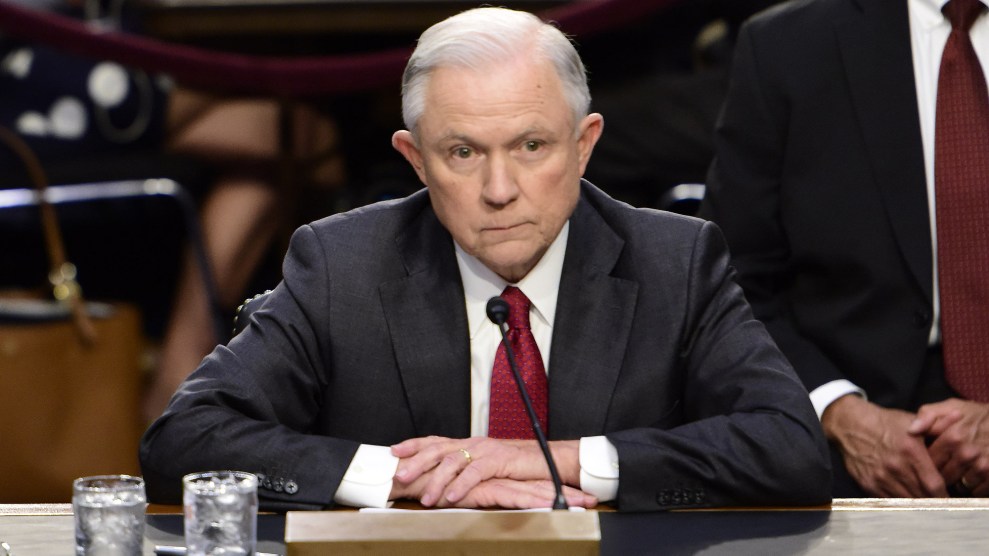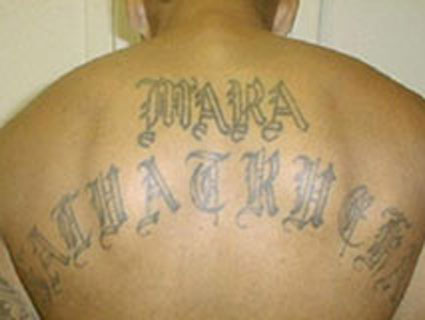
Secretary of Homeland Security Kirstjen Nielsen listens as President Donald Trump speaks during a meeting with law enforcement officials on the MS-13 street gang and border security. Evan Vucci/AP/AP
There’s one thing everyone can agree with President Donald Trump on about the street gang MS-13: The group specializes in spectacular violence. Its members attack in groups, in the woods, at night, luring teens to their deaths with the promise of girls or weed. One Long Island boy told me he doesn’t go to parties anymore because he worries any invitation could be a trap. A victim’s father showed me a death certificate that said his son’s head had been bashed in, then lowered his voice and added that the boy’s bones had been marked by machete slashes, but he didn’t want the mother to know that. A teenager who has left the gang told me he considers himself dead already, and is just trying to make sure MS-13 doesn’t kill his family.
I’m spending the year reporting on MS-13 members and their associates. I’ve been combing through their text messages. I’m talking with the detectives building cases against killers not yet old enough to buy cigarettes. And I’ve been spending long evenings with the gang’s victims, who often start crying as soon as they start talking about the violence that has marred their lives. Everyone agrees the gang is bloodthirsty. Most of the other assertions I’ve heard from the Trump administration this year about MS-13 have almost no connection to what I’m seeing on the ground.
1. MS-13 Is Not Organizing to Foil Immigration Law
Trump often talks about how MS-13 has carried out a string of murders in the suburbs outside New York City. One of the first things I did when I started reporting was talk to the ex-girlfriend of the gang leader charged with ordering six of those killings in 2016 and 2017. The girl sat at a Panera Bread in a Long Island strip mall and told how he had kidnapped and raped her shortly after her 15th birthday, threatened her family, and forced her to get a tattoo of his name on her arm. As I talked to her, I imagined a man like the ones I had seen in news reports on MS-13—chins jutted out, arms strong from lifting weights, and gothic tattoos of the letters M and S on their faces and chests. I was shocked when I eventually saw this gang leader in court; he was a baby-faced 19-year-old who blushed when girls waved to him from the gallery. The indictment against him laid out killings that were ordered in response to adolescent trash talking.
Attorney General Jeff Sessions has called MS-13 the most brutal of the gangs driving the drug trade, and promised to go after the group like the government went after mob boss Al Capone. Really, experts have found the gang has barely any role in the international drug trade. The Congressional Research Service said that it could be misleading to call MS-13 a transnational criminal organization at all, because it has no central leader or global ambitions. The gang is made up of sometimes competing cliques, often led by teenagers most interested in wielding power over other young people in their immediate circles.
On Long Island, a detective told me police officers call MS-13 members “mighty munchkins,” because they have often not yet hit their growth spurts and tend to commit their crimes in large groups. They meet at night because, while other criminal organizations have massive international revenue streams, these guys—even the leaders—have to work menial jobs and sometimes go to school during the day. Each clique has its own shot caller, and its own hyperlocal focus. On Long Island, the gang’s focus has often been on controlling the halls of a single high school.
2. MS-13 Is Not Posing as Fake Families at the Border
In justifying the policy of child separation last week, Secretary of Homeland Security Kirstjen Nielsen said, “The kids are being used as pawns by the smugglers and the traffickers. Those are traffickers, those are smugglers and that is MS-13.” The theory is that Central American gang leaders are showing up at the border falsely claiming to be the parents of children, and are also instructing unaccompanied minors to go to the U.S. and claim territory.
Actually, there have been fewer than 200 cases of false family claims this year—a fraction of 1 percent of the total number of families apprehended at the border—and there is no indication that any of those cases involved MS-13. Of the hundreds of thousands of unaccompanied minors that have come to the U.S. since 2012, Border Patrol says only 56 were suspected of MS-13 ties.
The gang is trying to find new members, but there’s no need to step on the toes of the Mexican gangs that control human smuggling to do it. Long Island teenagers tell me that when they show up to school, gang members sit down next to them at lunch and ask them to join. Many—worn down by loneliness, boredom and the threat of violence if they try to refuse—accept the invitation.
People who study MS-13 agree that when young gang members travel from El Salvador to the U.S., they are driven by the same economic factors driving other Central American immigrants. Even the 19-year-old gang leader charged with six murders on Long Island told his ex-girlfriend he was not a member of the gang when he came to the U.S. from El Salvador. He said it was only later, in the New York suburbs, that he was recruited.
And some MS-13 members are born right here. The Suffolk County Police Department examined a sample of active MS-13 members and found that just a quarter had come to the U.S. as unaccompanied minors. The natural conclusion: This is not a border issue. It’s a recruitment issue.
3. MS-13 Is Sticking Around, but It’s Not Growing
Trump talks about the gang as if it is suddenly taking over. “The weak illegal immigration policies of the Obama Admin. allowed bad MS 13 gangs to form in cities across U.S.,” he wrote in a tweet.
MS-13 has been stubbornly persistent, but it remains a boutique criminal organization, accounting for a tiny portion of 1.4 million gang members nationwide. Trump’s Justice Department says there are about 10,000 MS-13 members in the U.S., the same number as 10 years ago. There’s also nothing new about MS-13 alarmism. Back in 2005, Newsweek ran a cover story about the group, citing its 10,000 members, under the headline, “The most dangerous gang in America.”
On Long Island, the murder people cite most often when talking about MS-13’s brutality is the killing of a two-year-old and his mother back in 2010. But the gang’s history goes back much further than that; the FBI set up a Long Island task force to crack down on the gang in 2003. And MS-13 never invaded the U.S at all. It was founded in Los Angeles in the 1980s, and then mixed with California prison gang culture and was exported to El Salvador.
The group remains significantly smaller than the Crips, the Bloods and the Latin Kings; it’s also smaller than several gangs you’ve probably never heard of, like the Gangster Disciples in Chicago. Even the Center for Immigration Studies, which has been labeled an extremist group for its anti-immigrant ideology, can’t come up with more than an average of 35 murders per year attributed to MS-13—far fewer than that Chicago gang you didn’t know existed.
MS-13 is not the largest, the most violent, or the fastest-growing gang, but it is the U.S. gang most strongly tied to Central America, which is where the majority of asylum-seeking teenagers come from. In that way, it’s the perfect focal point for Trump’s message of closed borders.
4. MS-13 Is Preying on a Specific Community, Not the Country at Large
When confronted last week with audio obtained by ProPublica of wailing children separated from their parents, White House Communications Adviser Mercedes Schlapp said, “What’s very heartbreaking is to watch Americans who have lost their children because of the MS-13 gang members.” But the vast majority of MS-13 victims are young immigrants, many of them undocumented.
I often think about this when I’m out reporting. This year, I have reached out to current gang members and added them as friends on Facebook. I’ve visited the homes of people on the local clique’s kill list, and heard their police-issued panic buttons hum under tables and behind doors. I’ve explored the wooded areas Long Island police call “the killing fields,” where bodies have been found. I feel safe doing this because MS-13 rarely goes after true outsiders—people who are not friends with any gang members or targets for recruitment. The closest I’ve found in Long Island to a totally random victim was a worker at a Central American deli who was hurt when a bullet passed through the head of a targeted victim.
The White House put out a statement last month that described recent murders carried out by “MS-13 animals.” Lost in the controversy over whether it was OK to call gang members animals was the fact that of the six identified victims, five were immigrants and the other was a child of immigrants.
5. Immigration Raids and Deportation Can Only Go So Far
Secretary Nielsen said last week that the presence of MS-13 in the U.S. is “the exclusive product of loopholes in our federal immigration laws.” The loopholes she is talking about are actually specific protections contained in United Nations conventions on refugees and torture, which the U.S. ratified. The U.S. is obligated to allow Central American immigrants to stay in the country while their asylum claims are processed, which can take years. If the person pleading asylum is a minor, they are supposed to be released to relatives.
But if U.S. officials determine that a teenager is a gang member, they stay in custody. And immigration officials can also re-detain teenagers who are recruited into MS-13 once they get here. Dozens of Long Island teenagers were re-detained last year on suspicion of gang ties. The problem is that it can be hard to tell who is in the gang and who is just adopting gang style. MS-13 has its own music and aesthetic, bound up in Central American pride. On Long Island, some immigrant teens use MS-13 markers as a fashion statement, the way American kids might once have worn the blue bandanas associated with the Crips because they liked Snoop Dogg.
I sat in on one hearing for a Long Island 17-year-old who had been detained for half a year after he wrote the El Salvador telephone code, “503,” in a notebook at school. He had spent some of that time in a detention center now under investigation for child abuse. At the hearing, an immigration judge ordered the teen released and openly mocked the gang charges. “I note that ‘503′ is an area code,” the judge said. “He may have had his grandmother’s phone number written in his notebook. We don’t know. But I think this is slim, slim evidence on which to base the continuing detention of an unaccompanied child.”
That’s not to say that all of the immigrant teenagers accused of gang affiliation are innocent. But Immigration and Customs Enforcement has arrested some 8,000 suspected MS-13 members in the past decade. If deportation was all it took, the gang would be gone by now.
So What?
This all matters because the gang really is terrorizing a portion of the population: young Latino immigrants in a few specific communities.
Last month, I accompanied the mother of a high school freshman killed by MS-13 to a Trump event on Long Island. Inside a government building, the president railed against the gang. “They killed a cop for the sake of making a statement. They wanted to make a statement, so they killed a cop,” he said. (They did not kill a cop.)
Outside, the mother drifted between a pro-Trump rally and a counter protest. She took tranquilizer pills so she could face local reporters, and then told them she was unsure if Trump really cared about victims like her. She said she hoped the president’s fixation on MS-13 might spur changes that will keep other kids from being attacked and recruited by the gang.
But for any policy to work, it needs to be rooted in reality.
ProPublica is a Pulitzer Prize-winning investigative newsroom. Sign up for their newsletter.















